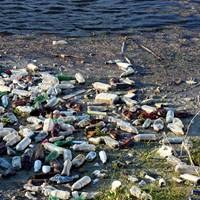(BRUSSELS) – The EU made a bid for leadership in the global battle against plastic waste Tuesday by setting out a bold strategy to get rid of the single-use plastics that pollute Europe’s seas, rivers and countryside.
The first-ever Europe-wide strategy on plastics, adopted by the European Commission, is part of a broader EU plan towards a more circular economy, sets out to protect the environment from plastic pollution whilst at the same time promoting growth and innovation, turning a challenge into a positive agenda for the Future of Europe.
The EU executive says there is a strong business case for transforming the way products are designed, produced, used, and recycled in the EU. Taking the lead in this transition will create new investment opportunities and jobs, it says.
Under the new plans, all plastic packaging on the EU market will be recyclable by 2030, the consumption of single-use plastics will be reduced and the intentional use of microplastics will be restricted.
“If we don’t change the way we produce and use plastics, there will be more plastics than fish in our oceans by 2050,” said EC first vice-president Frans Timmermans: “We must stop plastics getting into our water, our food, and even our bodies. The only long-term solution is to reduce plastic waste by recycling and reusing more.”
Vice-president Jyrki Katainen added: “With our plastic strategy we are laying the foundations for a new circular plastics economy, and driving investment towards it. This will help to reduce plastic litter in land, air and sea while also bringing new opportunities for innovation, competitiveness and high quality jobs.”
He said there was a great opportunity for European industry to “develop global leadership in new technology and materials”.
Every year, Europeans generate 25 million tonnes of plastic waste, but less than 30% is collected for recycling. Across the world, plastics make up 85% of beach litter. And plastics are even reaching citizens’ lungs and dinner tables, with microplastics in air, water and food having an unknown impact on their health.
The Commission says the new plastic strategy will transform the way products are designed, produced, used, and recycled in the EU. It says its goal is to protect the environment whilst at the same time ‘lay foundations to a new plastic economy, where the design and production fully respect reuse, repair and recycling needs and more sustainable materials are developed’.
The Commission has adopted a Monitoring Framework, composed of a set of ten key indicators which cover each phase of the cycle, which will measure progress towards the transition to a circular economy at EU and national level.
Under the new strategy, the European Union will:
- Make recycling profitable for business: New rules on packaging will be developed to improve the recyclability of plastics used on the market and increase the demand for recycled plastic content. With more plastic being collected, improved and scaled up recycling facilities should be set up, alongside a better and standardised system for the separate collection and sorting of waste across the EU. This will save around a hundred euros per tonne collected. It will also deliver greater added value for a more competitive, resilient plastics industry.
- Curb plastic waste: European legislation has already led to a significant reduction in plastic bag use in several Member States. The new plans will now turn to other single-use plastics and fishing gear, supporting national awareness campaigns and determining the scope of new EU-wide rules to be proposed in 2018 based on stakeholder consultation and evidence. The Commission will also take measures to restrict the use of microplastics in products, and fix labels for biodegradable and compostable plastics.
- Stop littering at sea: New rules on port reception facilities will tackle sea-based marine litter, with measures to ensure that waste generated on ships or gathered at sea is not left behind but returned to land and adequately managed there. Also included are measures to reduce the administrative burden on ports, ships and competent authorities.
- Drive investment and innovation: The Commission will provide guidance for national authorities and European businesses on how to minimise plastic waste at source. Support for innovation will be scaled up, with an additional 100 million financing the development of smarter and more recyclable plastics materials, making recycling processes more efficient, and tracing and removing hazardous substances and contaminants from recycled plastics.
- Spur change across the world: As the European Union does its own homework, we will also work with partners from around the world to come up with global solutions and develop international standards. We will also continue to support others, as we have done with the clean-up of the Ganga River in India.
The new Directive on port reception facilities proposed today will now go to the European Parliament and Council for adoption.
Subject to Better Regulation requirements, the Commission will present the proposal on single-use plastics later in 2018.
Stakeholders have until 12 February 2018 to contribute to an ongoing public consultation.
The Commission also announced the launch of work on the revision of the EU’s Packaging and Packaging Waste Directive and preparation of guidelines on separate collection and sorting of waste to be issued in 2019.
For the full list of measures and their timeline, see the Annex to the Plastics Strategy.
The initiatives adopted by the College today take the form of:
- A Communication on a European Strategy for Plastics in a Circular Economy;
- A Communication on the Interface between Chemicals, Products and Waste;
- A Monitoring Framework on the Circular Economy;
- A new Directive on Port Reception Facilities.
They are complemented by a Report on Critical Raw Materials and the Report on Oxo-plastics.
A European Plastics Strategy: Questions & Answers



